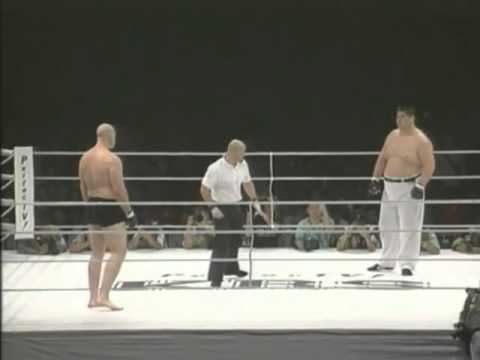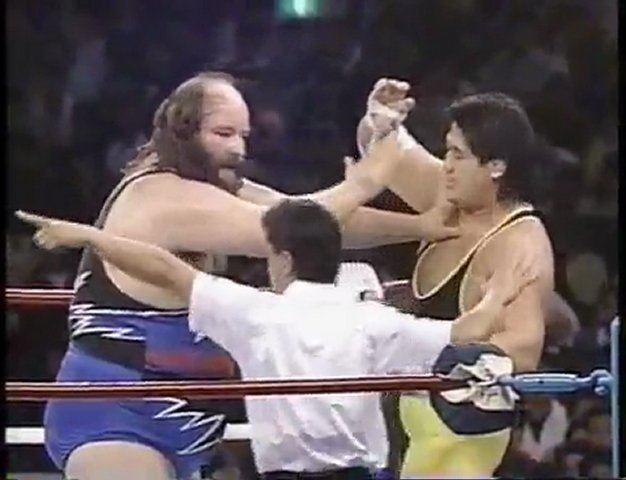Record 348-184-24 Name Koji Kitao Makuuchi rank Yokozuna Weight 157 kg | Debut March, 1979 Retired December, 1987 Role Sumo wrestler Height 2.01 m | |
 | ||
Special Prizes Outstanding Performance (5)Technique (2) Movies The Quest, UFC Classics: Ultimate Fighting Championship: Vol. 9 Similar People Chiyonofuji Mitsugu, Onokuni Yasushi, Hokutoumi Nobuyoshi, Asahifuji Seiya, John Tenta | ||
Super Fire Pro Premium Bas Rutten vs Koji Kitao
Kōji Kitao (born August 12, 1963) is a former sumo wrestler and professional wrestler, born in Mie, Japan. He was sumo's 60th yokozuna, and the only yokozuna in sumo history not to win a top division tournament championship. He was forced to leave sumo at the end of 1987 after a falling-out with his stable master Tatsunami, and became a professional wrestler in 1990.
Contents
- Super Fire Pro Premium Bas Rutten vs Koji Kitao
- Early career
- Promotion to yokozuna
- Downfall and expulsion
- Professional wrestling career
- American Wrestling Association 1989
- New Japan Pro Wrestling 1990
- Super World of Sports 1990 1991
- Various promotions 1991 1998
- Mixed martial arts career
- Sumo coaching role
- Other media
- In wrestling
- Championships and accomplishments
- References

Early career

Born in Tsu, Kitao made his professional sumo debut in March 1979 at the age of 15, joining Tatsunami stable, and he reached the top, makuuchi division in September 1984 after winning the championship in the jūryō division. In his second tournament in the top division he defeated yokozuna Kitanoumi and was awarded the Outstanding Performance prize and promotion to komusubi. He made his sekiwake debut in May 1985. In July 1985 he was back in the maegashira ranks but defeated two more yokozuna and was tournament runner-up with twelve wins. After finishing runner-up once more in November 1985 he was promoted to the second highest rank of ōzeki. Kitao continued his rapid rise with his third runner-up performance in May 1986, followed by a 14-1 score in July, his only loss being to Hoshi. He defeated yokozuna Chiyonofuji on the final day to force a playoff with him, which Kitao lost.
Promotion to yokozuna
After this result the Japan Sumo Association were faced with a difficult decision as there was only one yokozuna on the ranking lists, but five ōzeki, with a sixth wrestler - Hoshi (who would become yokozuna Hokutoumi), winner of the March 1986 tournament, already performing to ōzeki standard. The Association decided to promote Kitao to yokozuna and Hoshi to ōzeki. Kitao had won 36 bouts in the last three tournaments and been runner-up in the last two, so the defacto promotion standard of "two tournament championships or the equivalent" was interpreted rather loosely. He was just 22 years old and the first person to be promoted to yokozuna without any top division tournament titles since Terukuni in 1942. The Sumo Association insisted that Kitao could no longer compete under his family name at such an exalted rank so he adopted the shikona of Futahaguro, the name being formed from two highly successful former yokozuna from his stable, Futabayama and Haguroyama.
Downfall and expulsion
The decision to promote Futahaguro backfired and he proved to be a great embarrassment to the sumo establishment. His debut as a yokozuna in the September 1986 tournament saw him pull out on the seventh day with only three wins, and after two runner-up scores in November 1986 and January 1987 a series of mediocre performances followed. His best result as a yokozuna came in November 1987 when he was runner-up for the seventh time, with a 13-2 record. However, controversy was never far away from him. Several tsukebito (junior members) of his stable refused to serve under him following an incident on the 1987 winter tour in which he physically punished one of them and as a result of this, in December 1987 he had a heated argument with his stable boss, Tatsunami, and stormed out, allegedly striking Tatsunami's wife on the way. The elders of the Sumo Association responded, without giving Futahaguro a hearing, by voting to accept his "resignation". Futahaguro became the first yokozuna ever to be expelled from sumo this way. He had lasted just eight tournaments at yokozuna rank and had proved unable to win a championship.
Professional wrestling career
Upon being dismissed by the Sumo Association, Kitao was linked with a move to America's National Football League, but instead turned to professional wrestling. To mollify the association, he dropped the shikona and reverted to his real name.
American Wrestling Association (1989)
To prepare for his debut in Japan, he debuted in the United States for Verne Gagne's American Wrestling Association in November 1989, through Masa Saito's connections. To keep his identity a secret to the Japanese press, he wrestled under the masked persona, Monster Machine.
New Japan Pro Wrestling (1990)
Trained at the New Japan Pro Wrestling (NJPW) dojo, he made his Japanese debut on February 10, 1990, at the NJPW/AJPW Supershow in the Tokyo Dome, where he defeated Bam Bam Bigelow in a highly anticipated match. Unfortunately, his stay in NJPW didn't last long, because later that July, he was fired for disrespectful conduct towards the Korean-born Riki Choshu, who Kitao taunted using an ethnic slur.
Super World of Sports (1990-1991)
Upon joining SWS in November 1990, he joined the Revolution stable and teamed with fellow former sumo Genichiro Tenryu. In an appearance at the World Wrestling Federation's WrestleMania VII, Tenryu and Kitao defeated Demolition. During his match with another former sumo-turned-pro wrestler in John "Earthquake" Tenta on April 1, 1991 at a show in Kobe, Kitao and Tenta broke kayfabe by being uncooperative with each other. Kitao didn't sell Earthquake's attacks and shot on him. After Kitao was disqualified for kicking the referee, he immediately grabbed a microphone and began telling the audience that wrestling is fake and that Tenta never could really beat him, as other Japanese wrestlers attempted to restrain him. Because of the incident, Koji was subsequently fired from SWS.
Various promotions (1991-1998)
Kitao then wandered in martial arts and got a black belt in karate. In 1992 he returned to wrestling under his new martial arts persona by appearing in a UWF International event, defeating Kazuo Yamazaki. This enabled him to face UWF-i top star Nobuhiko Takada in a worked shoot wrestling match. Pre-match discussions over the outcome of the match led to an agreement being reached for a draw, but Takada saw an opportunity and double-crossed Kitao during the match, legitimately KO'ing him with a kick to the head. Takada had won, but the importance of the match was that Kitao was truly back into puroresu. Moreover, Kitao showed a more respectful personality, bowing to the crowd and shaking hands with Takada after the match.

In the following years he was recruited by his long-time friend Genichiro Tenryu for his Wrestle Association R promotion. Kitao also formed his own dojo and promotion called "Kitao Dojo", later changed to "Bukō Dōjō". Among the wrestlers that came out of the dojo were Masaaki Mochizuki, Yoshikazu Taru, and Takashi Okamura, who later became business partners of Último Dragón in his junior heavyweight ventures. In WAR, they competed as a stable led by Kitao, also called Bukō Dōjō.
On May 5, 1995, Kitao appeared in New Japan Pro Wrestling to reconcile with Riki Choshu, and wrestled a match along Antonio Inoki against Choshu and Tenryu. Kitao participated in some Martial Arts Festivals arranged by Inoki, beating foreign wrestlers like Crusher Kline, Glen Jacobs, and Mabel.
In 1997, he won his only title, the WAR World Six-Man Tag Team Championship, with Mochizuki and WAR rookie Nobukazu Hirai in October 1997. They retained it for a year, dropping it in 1998 against Koki Kitahara, Lance Storm and Nobutaka Araya. Koji retired from pro wrestling in October 1998, celebrating his retirement ceremony in the PRIDE 4 event.
Mixed martial arts career
From 1996 to 1997, Kitao would have three mixed martial arts bouts. The first of them was for the Brazilian company Universal Vale Tudo Fighting, where he faced luta livre veteran Pedro "The Pedro" Otavio. Kitao fought as Bukō Dōjō representative, wearing his sleeveless karategi and being cornered by his apprentices. Started the fight, Kitao immediately rushed Pedro to the corner and took him down, gaining dominant position over him thanks to his much bigger size. The sumo champion spent most of the bout smothering Otavio from the half guard, but the Brazilian lutador eventually managed to get free and gain Kitao's back, from where he threw seven vicious elbows to his spine, making him tap.
Kitao's second MMA fight was at the Ultimate Fighting Championship event UFC 9, facing Mark Hall. The fight was fast, as though Kitao took him down in seconds, one of Hall's punches broke his nose and made him bleed profusely, forcing the referee to stop the match for Hall's win. Koji later was invited to PRIDE 1, where he faced future WWE employee Nathan Jones. The Australian fighter caught Kitao in a standing guillotine choke and hit some knee strikes to the gut, but Koji trapped his leg and took him down, landing in side control. Kitao then worked an americana and Jones immediately tapped.
Sumo coaching role
In the summer of 2003 he made a surprise return to the world of sumo when he was invited to oversee some practice sessions at his former Tatsunami stable. His return was possible thanks to the retirement of Kitao's old stablemaster Haguroyama Sojō, who had been accused of illegally pocketing money from the stable fundings. Kitao was invited by the new stablemaster thanks to the makushita Haguroumi, who had served as a tsukebito to Kitao in the past. Though Kitao and Haguroumi were on bad terms, Haguroumi asked for a reappraisal of Kitao's case, and it was clear that most of what was alleged to have taken place between Kitao and Sojō was made up by the latter.
